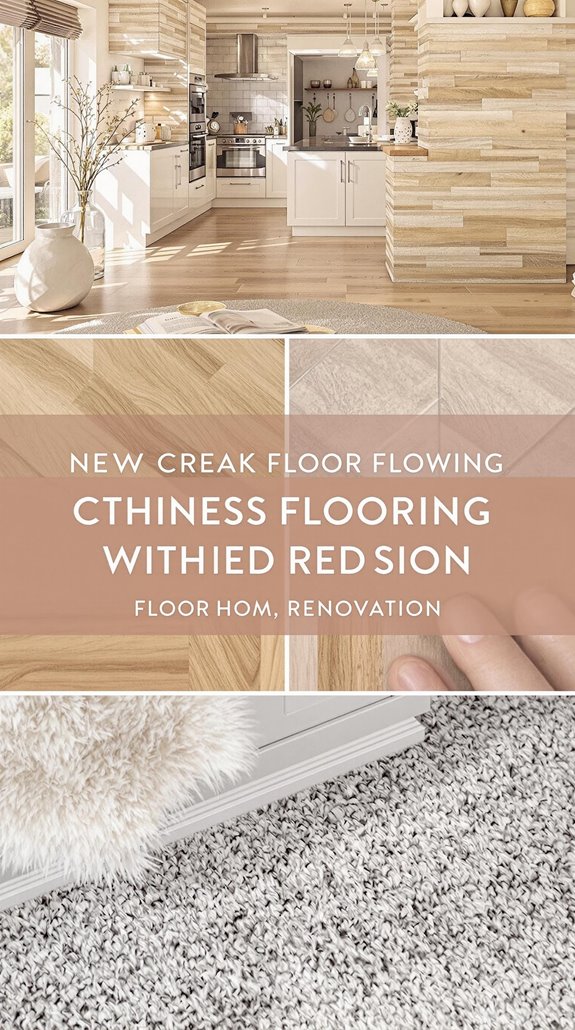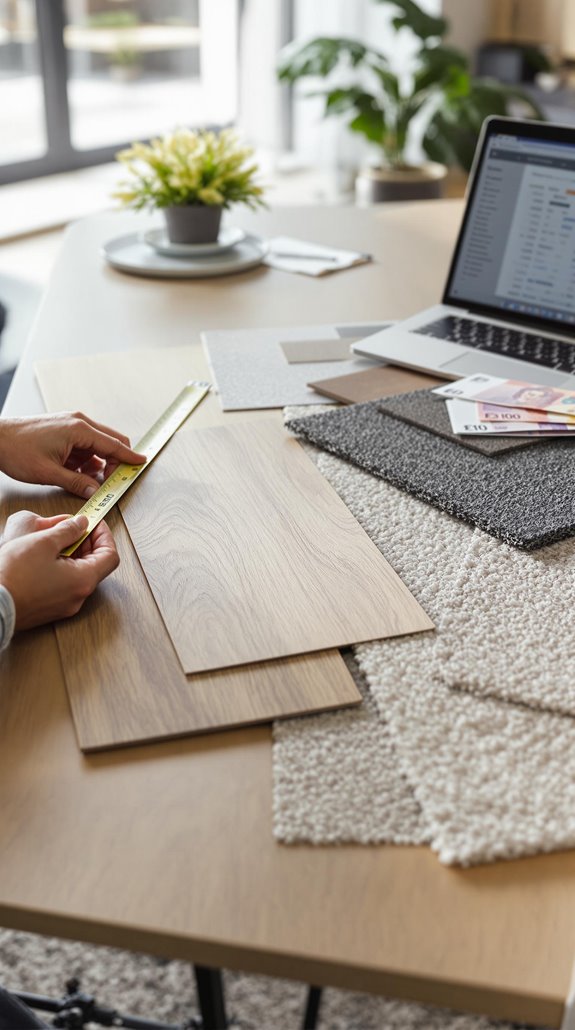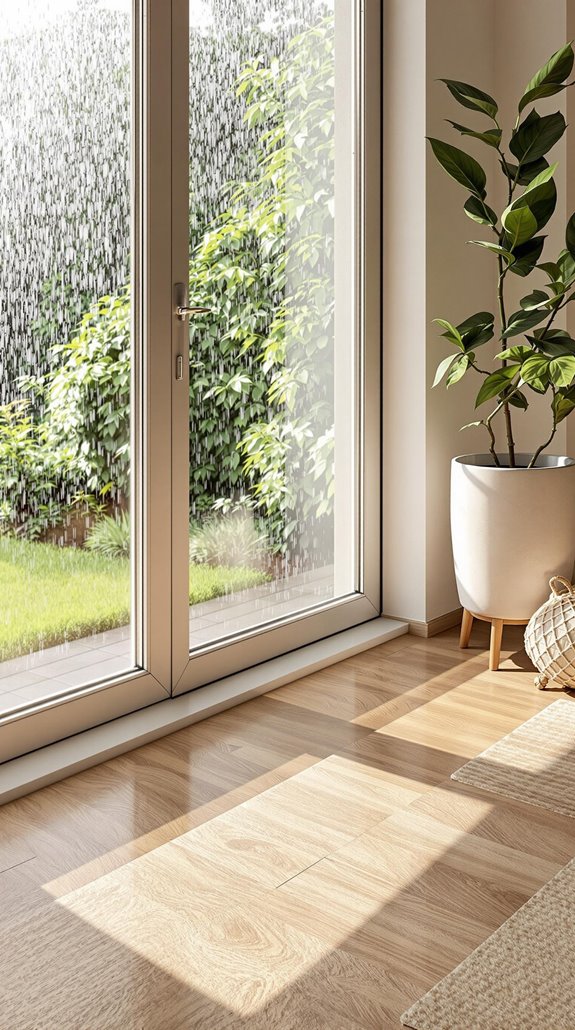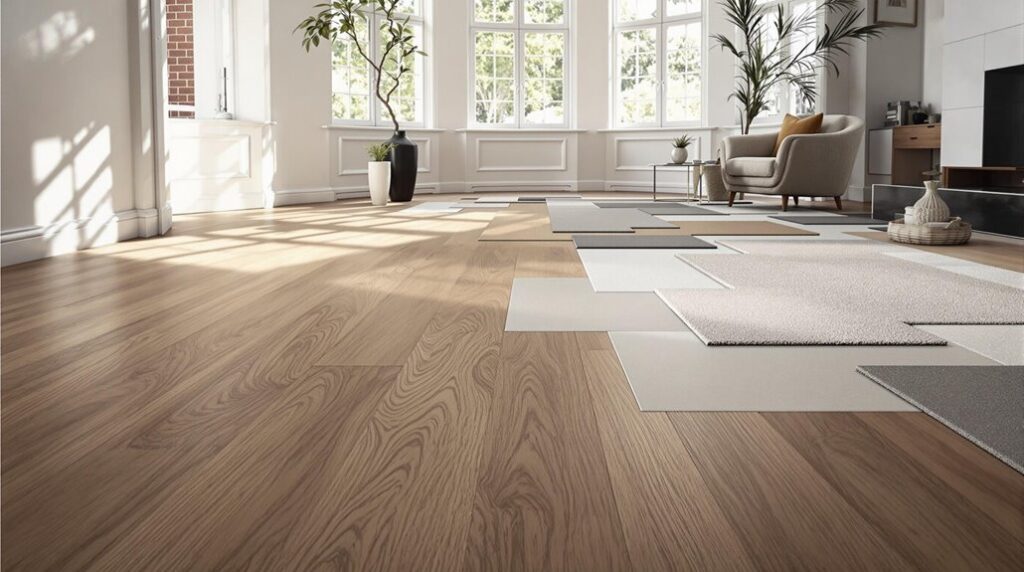I’ve seen countless UK homeowners make costly flooring mistakes that could’ve been avoided with proper planning. When I’m evaluating a renovation project, I focus on five critical factors that’ll determine whether your investment pays off or becomes a maintenance nightmare. Each room presents unique challenges—from moisture levels in your bathroom to foot traffic patterns in your hallway. Let me walk you through the systematic approach I use to match materials with requirements.
Key Takeaways
- Consider room-specific needs: bathrooms require water-resistant materials, kitchens need spill-resistant surfaces, bedrooms prioritize comfort.
- Plan for UK climate factors including temperature swings, humidity control, and allow 48-72 hours for timber acclimatisation.
- Budget £20-£90 per square metre for materials plus £20-£40 installation, ordering 5-10% extra for wastage.
- Choose durable options based on traffic: porcelain tiles last 50+ years, hardwood 30+ years, vinyl 15-20 years.
- Follow 2025 trends of warm wood tones, natural textures, and herringbone patterns for contemporary aesthetic appeal.
Understanding Room-Specific Flooring Requirements

When planning flooring for each room, I’ll assess the specific functional demands that dictate material selection. Your bathroom requires water-resistant materials—hardwood’s simply not viable here due to moisture damage and warping risks. I’ll prioritize mold-resistant options that handle humid conditions effectively.
For kitchens, you’ll need spill-resistant surfaces that withstand frequent cleaning and heavy foot traffic. Hardwood works but demands protective measures against water damage from sinks and appliances.
Living areas offer more flexibility, though open-plan layouts connecting to kitchens still need moisture consideration. Consider requesting free king-size samples to help visualize how different flooring options will look and feel in your specific living space before making your final decision. Bedrooms prioritize comfort and warmth—carpet delivers underfoot comfort while hardwood provides durability and easy maintenance.
Hallways and entrances face the harshest conditions with heavy traffic, dirt, and moisture from weather. I’ll recommend extremely durable materials with protective strategies like entrance mats.
Comparing Material Durability and Maintenance Needs
Since durability directly impacts your renovation budget over time, I’ll examine each material’s lifespan and maintenance requirements to help you make cost-effective decisions.
Hardwood floors deliver exceptional longevity—exceeding 30 years with proper care. You’ll need regular sweeping and occasional refinishing, but this investment pays dividends. Proper insulation is also important to maximize the energy efficiency of your home when choosing flooring.
Engineered wood offers 20-30 years with minimal upkeep; dry mopping suffices for most situations.
Bamboo flooring lasts 20-25 years but requires protective coatings to prevent water damage. It’s an eco-conscious choice that fellow renovators increasingly favor.
Porcelain tiles dominate durability charts, lasting 50+ years with minimal wear. Annual grout sealing represents your primary maintenance task.
Vinyl flooring provides 15-20 years of service with simple damp mopping. While shorter-lived, it’s incredibly resilient to scratches and spills. Carpet adds plush texture and warmth to your home, making it ideal for colder climates.
Budget Planning for 2025 UK Flooring Costs

Although material quality remains paramount, your 2025 flooring budget demands precise calculations across multiple cost categories. I’ll break down the essential cost components you’ll encounter during your renovation project.
Material costs vary greatly: engineered wood ranges £20-£90 per square metre, solid wood £30-£60, and parquet £20-£50. These figures exclude underlay and adhesives you’ll need. Remember to order 5-10% extra flooring to account for cutting wastage and future repairs. Additionally, consider regional price variations which can significantly impact your overall budget.
Installation adds substantial expense. Expect £20-£35 per square metre for engineered wood, £25-£40 for solid wood, and £30-£45 for parquet installation.
Additional project costs include floorboard replacement at £45 per square metre, door trimming at £30 per door, and floor levelling between £6-£30 per square metre. Don’t forget carpet removal at £7 per square metre if you’re replacing existing flooring.
Current Design Trends and Aesthetic Considerations
Today’s flooring trends emphasise natural textures and sophisticated patterns that’ll transform your renovation into a contemporary showcase. I recommend incorporating herringbone patterns, which create warm atmospheres while offering waterproof vinyl options for moisture-prone areas. You’ll find warm wood tones replacing cooler greys, with light oak finishes enhancing natural light and spatial perception throughout your home. Additionally, selecting flooring that aligns with sustainable materials can further reduce your renovation’s environmental impact.
Textured surfaces add authentic depth through 3D-printed grain patterns and raw, unfinished looks that avoid dated orange undertones. Large format tiles and terrazzo provide sleek, expansive appearances perfect for modern aesthetics. Focus on natural colours and earthy tones that create cosy, inviting spaces. Clear-oiled finishes offer elegant protection while maintaining organic appeal. These trend-forward choices guarantee your renovation aligns with contemporary design preferences while maintaining long-term style relevance.
For rustic wood designs, consider options that showcase pronounced knots and cracks, as these natural imperfections significantly enhance the authentic character of your flooring choice.
Climate Factors and Environmental Impact on Flooring Choice

While aesthetic trends guide your initial flooring decisions, the UK’s demanding climate conditions will ultimately determine your renovation’s long-term success. I’ll walk you through the critical factors that separate successful installations from costly failures.
First, assess your regional challenges. Northern homes need enhanced thermal insulation—cork flooring reduces heat loss by 15%. Coastal properties require salt-resistant materials like porcelain tiles and marine-grade stainless steel fixings. Urban locations demand chemically stable materials that withstand pollution. Additionally, consider the importance of air tightness in your home’s overall energy efficiency, as it can significantly impact heating costs.
Temperature swings exceeding 10°C amplify wood movement considerably. I recommend engineered wood over solid planks—it reduces seasonal movement by 40%. For high-moisture areas, laminate offers 99% dimensional stability. Always maintain 40-60% indoor humidity year-round and install vapor barriers under ground-level flooring to prevent rising damp. Allow timber flooring a minimum 48-72 hours acclimatisation period before installation to prevent warping and gaps.
Conclusion
I’ve covered the essential technical factors you’ll need to evaluate when selecting flooring for your UK renovation project. You’ll want to cross-reference material specifications against room requirements, calculate total project costs including underlayment and installation tools, and assess durability ratings for high-traffic areas. Don’t forget to factor in your local climate’s moisture levels and temperature fluctuations when making your final selection. Your flooring choice will greatly impact your project’s long-term performance and maintenance schedule.
References
- https://floormart.co.uk/blog/top-flooring-trends-in-the-uk-for-2025/
- https://www.blackmountainsinteriors.co.uk/post/a-complete-guide-to-choosing-the-right-flooring-for-your-home
- https://flooring365.co.uk/blog/post/how-much-does-wood-flooring-cost-in-the-uk-a-realistic-2025-pricing-guide.html
- https://www.pettyson.co.uk/about-us/our-blog/244-7-tips-to-help-you-select-the-perfect-flooring-for-your-home
- https://flooring365.co.uk/blog/post/the-top-flooring-trends-for-2025-fresh-looks-for-every-home.html
- https://www.lumberkingflooring.co.uk/blog/post/living-room-flooring-a-comprehensive-guide-for-uk-homes
- https://justwood.co.uk/which-rooms-of-the-home-are-best-for-hardwood-floors/
- https://mrsander.co.uk/articles/wood-floor-renovations-articles/why-floors-should-always-be-done-before-walls-in-a-renovation-project/
- https://resand.co.uk/flooring-types-longevity/
- https://tekaflooring.co.uk/blog/flooring-durability-comparison/

